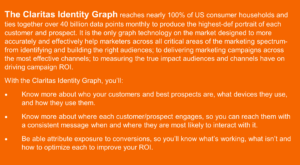
The Identity of the Hotel/Resort Market
And the Importance of an Intelligent Identity Graph
The Hotel & Resort market is expected to exhibit an annual growth rate of 3.82% over the next five years, which would result in a market volume of over $128B by 2028. While growth and expansion are likely, inflation, labor shortages, cybersecurity demands, and changing consumer expectations, mean the hospitality industry is still fraught with challenges and highly competitive. Therefore, hotels and resorts are constantly seeking innovative ways to identify, reach and engage with their target audience. One of the most effective weapons in their marketing arsenal is the use of an identity graph.
An identity graph is a comprehensive database that collects and connects various pieces of information about individual consumers across different devices and channels. It creates a unified view of each customer, allowing businesses to deliver more targeted and personalized marketing campaigns.
PRO TIP: Privacy compliance is increasingly vital within all industries. Insure the Identity Graph you use has a specific process for collecting, analyzing ang making actionable insights that meet, or even exceed, industry privacy requirements.
An effective, intelligent identity graph can provide a deeper understanding of your hotel/resort customers. By aggregating data from various touchpoints such as website visits, social media interactions, and booking history, the graph can help you gain a detailed customer profile. Armed with this information, you can then create highly targeted marketing campaigns. Whether it’s sending personalized email offers, targeted social media advertisements, and/or customized website content, identity graphs enable hotels to deliver the right message to the right person at the right time.
PRO TIP: It is vital you know the most about your best customers – not just age and income range, but how they prefer to shop & purchase. What social media, TV, audio, and publications do they indulge in? Do they travel by car or plane and would they prefer a package plan? Do they travel with groups or alone? Knowing their preferences allows you to attract similar prospects using the right media at the right time. An effective identity graph paired with a well-designed multichannel plan, is invaluable.
In addition, by leveraging an identity graph, you can personalize every step of the hotel guest journey. From the moment a guest starts researching their trip to the post-stay follow-up, communications and services can be tailored to meet the needs and preferences of each individual.
PRO-TIP: While 39% of travelers say their travel budgets will be higher this year, their expectations are also on the rise. From room ambiance to service, they want the best they can get for their personal and/or business budget. Personalizing that journey will not only provide them a great experience, but will keep them coming back. Returning customers provide you with a stable base that allows you to grow and expand your business, they are likely to spend more money, and typically represent those that are actively promoting your business. That’s a win, win, win!
Identity graphs also provide the intel necessary to allocate your marketing budget most effectively. Measurement and campaign optimization is one of the biggest challenges marketers face. And when it comes to full funnel ROI, the percentage of marketers who are confident they can gain an accurate measurement, greatly declines. What channels are working best? Who is seeing my messaging and turning into a conversion? By targeting the most relevant audience segments with personalized messages, you can increase conversion rates and maximize the ROI of your marketing campaigns. Connecting people to devices and behaviors is critical to attributing exposures to conversions. You’ll know what’s working, what’s not, and how to optimize campaigns.
PRO-TIP: An intelligent identity graph measures performance in several key ways:
• Connecting exposures to conversions allows you to connect the dots in a customer’s purchasing journey. It enables you to analyze and understand how multiple online and offline engagements with the same customer contribute to a sale.
• Applying attribution analysis allows you to know more about when, how, and if various marketing channels are moving your audiences to conversion from the first touch to last.
• Using “incremental lift analysis”, you can isolate conversions by channel, device, message or partner, and measure their effectiveness.
See it In Action: Omni Resorts and Hotels
Omni Hotels & Resorts owns and operates more than 50 upscale hotels & resorts in leading business gateways and destinations across North America. In an effort to drive new guests to book stays at their properties, Omni sought to gain a deeper understanding of their ideal guest profile in order to inform marketing strategies.
Omni engaged Claritas to perform an analysis of their customer information using Claritas PRIZM® Premier. The results indicated that their top 20 PRIZM Premier segments represent 29% of the households in the U.S. but accounted for over 66% of Omni guests. Many of the top socio-economic PRIZM Premier segments were also amongst the top segments for being Omni guests. Claritas then executed a multichannel marketing campaign using email, social media & programmatic display channels, promoting Omni hotels & resorts to a look-alike audience created from the Claritas Identity Graph.
During the 90-day pilot campaign, Claritas worked with the Omni marketing team to determine which creatives were getting the best engagement, allocating media spend toward ads that were performing best and removing or replacing any under-performing ads. Post-campaign measurement & analytics identified which segments performed best, which ones could be dropped from the audience and several that could be considered for the next campaign.
The Claritas Effect



